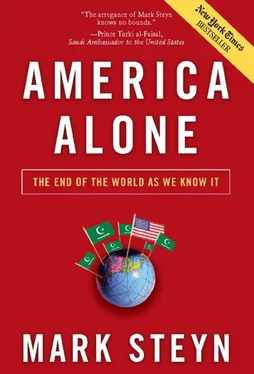1970 doesn’t seem that long ago. If you’re in your fifties or sixties, as many of the chaps running the Western world today are wont to be, your pants are narrower than they were back then and your hair’s less groovy, but the landscape of your life — the look of your house, the layout of your car, the shape of your kitchen appliances, the brand names of the stuff in the fridge — isn’t significantly different. And yet that world is utterly altered. Just to recap those bald statistics: in 1970, the developed nations had twice as big a share of the global population as the Muslim world: 30 percent to 15 percent. By 2000, they were at parity: each had about 20 percent.
And by 2020?
September 11, 2001, was not “the day everything changed,” but the day that revealed how much had already changed. On September 10, how many journalists had the Council on American-Islamic Relations or the Canadian Islamic Congress or the Muslim Council of Britain in their Rolodexes? If you’d said that whether something does or does not cause offense to Muslims would be the early twenty-first century’s principal political dynamic in Denmark, Sweden, the Netherlands, Belgium, France, and the United Kingdom, most folks would have thought you were crazy. Yet on that Tuesday morning the top of the iceberg bobbed up and toppled the Twin Towers.
This book is about the seven-eighths below the surface — the larger forces at play in the developed world that have left Europe too enfeebled to resist its remorseless transformation into Eurabia and that call into question the future of much of the rest of the world, including the United States, Canada, and beyond. The key factors are:
1. Demographic decline
2. The unsustainability of the advanced Western social-democratic state
3. Civilizational exhaustion
Let’s start with demography, because everything does.
If your school has two hundred guys and you’re playing a school with two thousand pupils, it doesn’t mean your baseball team is definitely going to lose, but it certainly gives the other fellows a big starting advantage. Likewise, if you want to launch a revolution, it’s not very likely if you’ve only got seven revolutionaries. And they’re all over eighty. But if you’ve got two million and seven revolutionaries and they’re’ all under thirty, you’re in business. I wonder how many pontificators on the “Middle East peace process” ever run this number: the median age in the Gaza Strip is 15.8 years.
Once you know that, all the rest is details. If you were a “moderate Palestinian” leader, would you want to try to persuade a nation — or pseudo-nation — of unemployed poorly educated teenage boys raised in a UN-supervised European-funded death cult to see sense?
Any analysis of the “Palestinian problem” that doesn’t take into account the most important determinant on the ground is a waste of time.
Likewise, the salient feature of Europe, Canada, Japan, and Russia is that they’re running out of babies. What’s happening in the developed world is one of the fastest demographic evolutions in history. Most of us have seen a gazillion heartwarming ethnic comedies — My Big Fat Greek Wedding and its ilk — in which some uptight WASPy type starts dating a gal from a vast, loving, fecund Mediterranean family, so abundantly endowed with sisters and cousins and uncles that you can barely get in the room. It is, in fact, the inversion of the truth. Greece has a fertility rate hovering just below 1.3 births per couple, which is what demographers call the point of “lowest-low” fertility from which no human society has ever recovered. And Greece’s fertility is the healthiest in Mediterranean Europe: Italy has a fertility rate of 1.2, Spain, 1.1. Insofar as any citizens of the developed world have “big” families these days, it’s the Anglo democracies: America’s fertility rate is 2.1, New Zealand’s a little below. Hollywood should be making My Big Fat Uptight Protestant Wedding, in which some sad Greek only child marries into a big heartwarming New Zealand family where the spouse actually has a sibling.
As I say, this isn’t a projection — it’s happening now. There’s no need to extrapolate, and if you do it gets a little freaky, but, just for fun, here goes: by 2050, 60 percent of Italians will have no brothers, no sisters, no cousins, no aunts, no uncles. The big Italian family, with papa pouring the vino and mama spooning out the pasta down an endless table of grandparents and nieces and nephews, will be gone, no more, dead as the dinosaurs. As Noel Coward once remarked in another context, “Funiculi, funicula, funic yourself.” By midcentury, Italians will have no choice in the matter. Experts talk about root causes. But demography is the most basic root of all. Many of the developed world’s citizens gave no conscious thought to Islam before September 11. Now we switch on the news every evening and, though there are many trouble spots around the world, as a general rule it’s easy to make an educated guess at one of the participants: Muslims vs. Jews in “Palestine,” Muslims vs. Hindus in Kashmir, Muslims vs. Christians in Africa, Muslims vs. Buddhists in Thailand, Muslims vs. Russians in the Caucasus, Muslims vs. backpacking tourists in Bali, Muslims vs. Danish cartoonists in Scandinavia. The environmentalists may claim to think globally but act locally, but these guys live it. They open up a new front somewhere on the planet with nary a thought. Why? Because they’ve got the manpower. Because in the seventies and eighties, Muslims had children (those selfdetonating Islamists in London and Gaza are a literal baby boom) while Westerners took all those silly doomsday tomes about “overpopulation” seriously. We still do. In 2005, Jared Diamond published a bestselling book called Collapse: How Societies Choose to Fail or Succeed. A timely subject, so I bought a copy. More fool me. It’s all about Easter Island going belly up because they chopped down all their trees. That’s why they’re not in the G-7 or a permanent member of the UN Security Council. Same with the Greenlanders and the Mayans and Diamond’s other curious choices of “societies.” Indeed, as the author sees it, pretty much every society collapses because it chops down its trees. Poor old Diamond can’t see the forest because of his obsession with the trees. Russia’s collapsing and it’s nothing to do with deforestation. It’s not the tree, it’s the family tree. It’s the babes in the wood. A people that won’t multiply can’t go forth or go anywhere. Those who do will shape the age we live in. Because, when history comes a-calling, it starts with the most basic question of all:
Knock-knock. Who’s there?
Demographic decline and the unsustainability of the social-democratic state are closely related. In America, politicians upset about the federal deficit like to complain that we’re piling up debts our children and grandchildren will have to payoff. But in Europe the unaffordable entitlements are in even worse shape: there are no kids or grandkids to stick it to.
In my town in New Hampshire, the population peaked in 1820 and then declined until 1940, when it started edging up again until it stands today almost at what it was two centuries ago. The opening up of the west killed Granite State sheep farming, and young people fanned out across the plains, or to the mill towns in southern New England. It’s sad to see cellar holes and abandoned barns and meadows reclaimed by the forest. But it didn’t kill my town because we had no extravagant social programs to which our old-timers had become partial. Similarly, in the post-Gold Rush Yukon, one minute the saloons are bustling and the garters of the hoochie-koochie dancers are stuffed with dollar bills; next they’re all shuttered up and everyone’s skedaddled out on the last southbound dogsled. But the territory isn’t stuck trying to figure who’s going to pay for the hoochie-koochie gals’ retirement complex. Unlike the emptying saloons of Whitehorse and Dawson City, demography is an existential crisis for the developed world, because the twentieth-century social-democratic state was built on a careless model that requires a constantly growing population to sustain it. You might formulate it like this:
Читать дальше












